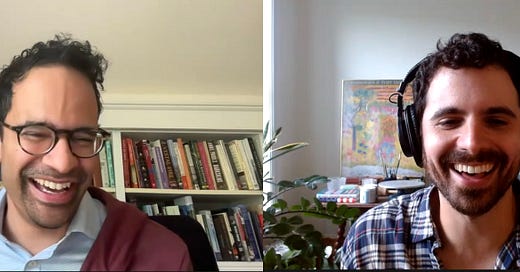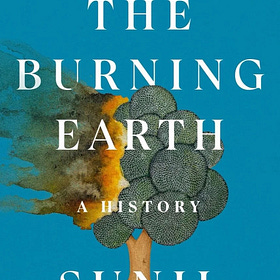In The Burning Earth, Professor Sunil Amrith delivers a global, history-spanning account of our planet’s environment. One subject he comes back to over and over again is food: rice, sugar, wheat, meat, and more. I asked him about the societal impact of each crop and why he believes there’s no faster way to slow the climate crisis “than changing food systems and agriculture.”
Sunil Amrith is the Renu and Anand Dhawan Professor of History and professor in the School of the Environment at Yale University. He’s the author of five books and a recipient of multiple awards including a MacArthur “Genius” fellowship.
A condensed transcript of our conversation, edited for clarity, is below. You can also listen to us on the Skipped History podcast:
Ben: Let’s start with rice. Can you talk about the rice revolution?
SA: Absolutely. The story of rice goes back 10,000 years to its first cultivation in the Yangtze Valley of China, and its spread to Southeast and South Asia. The big shift happened around 1,000 years ago with the introduction of a strain called Champa rice, from present-day Vietnam. This variety was fast-growing and hardy, which allowed it to spread quickly through trade routes to China.
The Song dynasty consciously promoted its cultivation, sending thousands of bushels to southern China and educating farmers. Over 200 years, rice cultivation transformed, sustaining the world's largest population. This revolution spread rice agriculture across Asia and contributed significantly to China's population growth, with the population reaching 115 million by the 13th century—a third of the global population at that time.
Ben: You mention that through uncoordinated efforts over millennia, Asian farmers developed over one hundred thousand varieties of rice. One hundred thousand!
SA: But all with a single origin: the Oryza sativa plant.
Ben: I was thinking how funny it’d be if, after writing there are “more than one hundred thousand varieties of rice,” you added, “and here they are: basmati, jasmine, Carolina...”
SA: I’d need to add a couple hundred pages!
Ben: Another food we should touch on briefly—because it might be listening to our discussion of rice and thinking Hey, what about me? I’m even hardier and more nutritious—is sweet potato, which played a vital role during the cooling period in the 17th century.
SA: Yes, sweet potatoes became crucial in China during this period of extreme climatic disruption that we call the Little Ice Age. The crop, which originated in the Americas and came to China via the Portuguese, thrived in less fertile soils and required less water than rice. If you look at sources from Taiwan in the 17th century, you see suggestions that sweet potatoes were used in everything: ground into flour, turned into noodles, and consumed in various different ways.
That said, it’s a dark irony of early modern environmental history that from the ruination of the Americas came sweet potatoes and the seeds of China’s survival.
Ben: Suffering seems to have frequently interacted with food—especially when it came to sugar.
SA: There are few crops more intimately connected with human suffering, I think, over the last 500 years.
There are multiple origin stories for sugar, but it was cultivated in Egypt in medieval times, from where it first entered the European palate. Sugar was initially seen as an extremely rare fine spice, like cinnamon or cloves. However, as demand grew in Europe, sugar plantations, particularly in the Caribbean and Brazil, were established, fueled by the brutal exploitation of enslaved people. And sugar went from being a precious substance to one that spread throughout society.
Ben: You detail a “tightening of the knot between human suffering and the destruction of other forms of life.” Can you elaborate?
SA: I think the plantation as an institution really embodies that. The plantation is a particular form of agriculture designed to extract maximum output in the minimum possible time. It involves, for starters, mass deforestation, partly to make it habitable for just one crop—in this case sugar—and partly because plantations are also very energy-intensive. Cut timber was fed into the furnaces.
When you look into this history, you see how a disregard for humanity is twinned with a disregard for nature—for every other form of life. And I think one of the things that interested me most when I was writing the book is this idea that some people start to have that they can dominate nature.
Ben: The rise of steam and railroad travel certainly tied into that conception. Can you talk about how transportation led to wheat cultivation?
SA: In the 19th century, wheat production exploded on several global frontiers, like the American Midwest and Ukraine, and on a smaller scale, in Punjab in India.
The introduction of rail and steam shipping allowed wheat to be transported quickly over long distances. Britain, for example, began importing food from as far away as Argentina and Australia because transportation became so quick and relatively inexpensive. In turn, of course, this change completely reshaped agrarian life in many parts of the world.
It also generated new patterns of inequality. The global market in wheat was helping urban workers in Europe—maybe even in larger cities in Asia—while at the same time creating new sorts of vulnerability in rural, agrarian areas of the Global South.
Ben: I was also interested in the "explosion of animal flesh" that you document during this period.
By the way, when I first made that note, I mistakenly wrote “animal fresh”—and then I was thinking there should be a meat delivery service called Flesh Direct.
SA: You might have a startup idea there.
Ben: I won’t quit my day job just yet.
SA: But, yes, we also saw dramatic rises in meat consumption tied to new forms of transportation, which enabled the rise of industrial slaughter in places like Chicago. Refrigeration was also crucial because it allowed meat to be transported further and preserved longer.
By the end of World War II, the U.S. was the largest food producer in the world. The war accelerated the industrialization of American agriculture, with fossil fuels playing a key role.
Ben: Related, the period of global history since 1945 has been called "the great acceleration” by climate scientists. What does that mean?
SA: It’s a way of describing hockey stick charts that show sharp upticks in—well, take any indication you'd like, carbon emissions being perhaps the most characteristic—around 1950.
Ben: I was curious about the great acceleration having different meanings for different people. From the perspective of the so-called Third World, historian and philosopher Dipesh Chakrabarty called the acceleration the dream of breaking out “from the waiting room of history.”
SA: That's right.
Ben: On one hand, that seems like a fair dream to have. On the other, I don't know how you could get tired of being in a waiting room and reading about Richard Gere as People's Sexiest Man Alive, 1999.
SA: Ha, I think you’ve been in nicer waiting rooms than me.
Ben: Fair enough.
SA: You know, as a point of context, Ben, at the time of political independence, life expectancy in India or Indonesia or Nigeria was about 30 years. If you imagine the colossal scale of the social challenges that these brand new states had to face, clearly one of them was providing adequate nutrition to their citizens. Famine was not at all a distant memory for the generation of political leaders who took power after colonialism.
And that’s partly why we also see what’s called the Green Revolution in the 1960s and ‘70s, which included genetic engineering of high-yielding rice and wheat seeds, the use of petrochemical fertilizers on a much larger scale, and, crucially, a massive increase in the exploitation of water for irrigation. The revolution made possible an astronomical increase in food grain output. It also created very, very deep inequalities in farming, the ballooning of agribusiness companies like Monsanto, and contributed to the rise of palm oil plantations.
So things begin to get ethically challenging. Today the demand for palm is leading to environmentally devastating deforestation, especially in Indonesia and Malaysia. On the other hand, palm oil is increasingly used as a biofuel that could reduce our reliance on coal and oil, and it’s more efficient than many other forms of vegetable oil.
A lot of these questions touch on consumer behavior, too. Palm oil is in everything: shampoo, cosmetics—it even stops ice cream from melting too quickly.
Ben: Well, let’s end by discussing consumer behavior, and not just my refusal to eat ice cream in anything but solid block form.
Almost a thousand years after the rice revolution, you write, “our most pronounced impact on the planet still comes from the most foundational of all human activities—growing food. Agriculture accounts for one quarter of greenhouse gas emissions.”
SA: Right. I’m certainly persuaded there's probably no single shift that would do more to slow the pace of the climate crisis than changing food systems and agriculture. To take it one step further, of all the foods it is clear that meat and dairy have the greatest planetary impact by far. There are many other things that we can and should do, but changing food habits is a huge one in terms of the impact, not only on emissions, but also on biodiversity.
But one of my conclusions at the end of writing The Burning Earth is that we must be cautious about dismissing or judging our everyday desires too harshly. Nothing is sort of deeper to our own identities than what we eat. It’s the basis of so many cultures. So the idea of top down policies telling us that we have to change what we eat—especially when our most impactful food habits are often the most cherished ones—is going to feel oppressive.
So, I certainly shy away from any talk of easy solutions but rather say let's start a conversation.
Ben: A conversation that could be improved (in my opinion) by marketing the splendors of, say, mushrooms versus the taste of I Can’t Believe It’s Not Pepperoni.
SA: Ha, yes, and more than that, I think we need to stop seeing environmental concerns as separate from our other struggles for justice. They’re all connected.






Absolutely loved this episode!
Really interesting discussion- and congratulations on the book, which I see comes out (on Audible, anyway) in a few days. My next Audible credit will go to The Burning Earth.